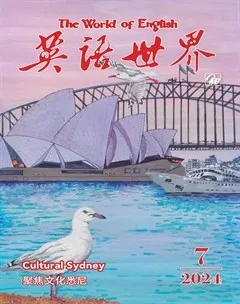Sydney-Side 彼岸悉尼
Where’s the steward?—Bar-room steward? Berth? Oh, any berth will do—
服务员在哪里?——酒吧服务员?舱位?哦,任何舱位都行——
I have left a three-pound billet just to come along with you.
我放下了三镑钱的工作,只是为了跟着你过来。
Brighter shines the Star of Rovers on a world that’s growing wide,
“漂泊者之星”在更加辽阔的世界也更加明亮,
But I think I’d give a kingdom for a glimpse of Sydney-Side.
但为了一瞥彼岸的悉尼,我愿意付出一个王国的代价。
Run of rocky shelves at sunrise, with their base on ocean’s bed;
日出时分,从海床上露出绵延的岩石架;
Homes of Coogee, homes of Bondi1, and the lighthouse on South Head2;
在海滨库吉和邦迪的家园,南头的灯塔。
For in loneliness and hardship—and with just a touch of pride—
因为孤独和艰辛——稍稍有点骄傲——
Has my heart been taught to whisper, ‘You belong to Sydney-Side.’
我的心暗自低语:“你属于彼岸的悉尼。”
Oh, there never dawned a morning, in the long and lonely days,
哦,我在那漫长而孤独的日子里,从来没有一个破晓的清晨,
But I thought I saw the ferries streaming out across the bays—
我甚至觉得我看到了渡轮横渡海湾——
And as fresh and fair in fancy did the picture rise again
幻想中,这个画面再次鲜活而美好,
As the sunrise flushed the city from Woollahra to Balmain:
就像日出把悉尼从东边的沃拉赫拉到西边的巴尔曼点亮:
And the sunny water frothing round the liners black and red,
阳光下的海水在黑色和红色的班轮周围泛起泡沫,
And the coastal schooners working by the loom of Bradley’s Head;
沿着布拉德利海岬的阴影,靠近海岸的帆船在艰难地前行;
And the whistles and the sirens that re-echo far and wide—
汽笛和警鸣声在四野回响——
All the life and light and beauty that belong to Sydney-Side.
所有这些光阴、光芒和美好都属于彼岸悉尼。
And the dreary cloud-line never veiled the end of one day more,
阴郁的云层不曾掩盖过另一天的尽头,
But the city set in jewels rose before me from ‘The Shore.’
但城市在“岸边”从珠光宝气中升起。
Round the sea-world shine the beacons of a thousand ports o’ call,
环绕着海洋的是无数港口的灯标,
But the harbour-lights of Sydney are the grandest of them all!
但悉尼的港灯最壮观璀璨!
Toiling out beyond Coolgardie3—heart and back and spirit broke,
在库尔加迪那边辛苦劳作——心灵和身体支离破碎。
Where the Rover’s Star gleams redly in the desert by the ‘soak’—
在沙漠中,在“泉水”旁,“漂泊者之星”赤热地闪耀——
But says one mate to the other, ‘Brace your lip and do not fret,
但是一个伙伴对另一个说:“挺住,不要沮丧,
‘We will laugh on trains and ’buses4—Sydney’s in the same place yet.’
我们会在火车和公交车上大笑——悉尼还在那里。”
Working in the South in winter, to the waist in dripping fern,
冬季工作在南方,湿淋淋的蕨丛到齐腰处,
Where the local spirit hungers for each ‘saxpence’ that we earn—
当地的氛围渴望着我们赚来的每一分钱——
We can stand it for a season, for our world is growing wide,
我们可以忍受一个季节,因为我们的世界正在变得辽阔,
And they all are friends and strangers who belong to Sydney-Side.
他们都是属于彼岸悉尼的陌生人和朋友。
‘T’other-siders5! T’other-siders!’ Yet we wake the dusty dead;
“彼岸者!彼岸者!”但是我们唤醒了尘封的死寂;
It is we that send the backward province fifty years ahead;
是我们把落后的地区向前推进了五十年;
We it is that ‘trim’ Australia—making narrow country wide—
是我们在“修整”澳大利亚——让狭窄的土地变得宽广——
Yet we’re always T’other-siders till we sail for Sydney-side.
但我们总是彼岸者,直到我们航行到彼岸悉尼。
* 博士,广东白云学院外国语学院、深圳大学外国语学院教授。(原诗出处: Henry Lawson. Verses Popular and Humorous, Angus and Robertson, Sydney, 1900, pages 10-12.)
1库吉(Coogee)和邦迪(Bondi)都是位于悉尼的知名海滨郊区。库吉位于悉尼中央商务区东南约8公里处,以其沙滩和轻松的氛围而闻名。而邦迪位于悉尼中央商务区东部约7公里处,以其标志性的邦迪海滩而著称,是冲浪和日光浴的热门景区。 2南头的灯塔是指南头(South Head,属于悉尼)上的霍恩比灯塔(Hornby Lighthouse),位于悉尼港入口处的南岬,为进入港口的船只提供航行指引。这里提及的地点唤起了叙事者对悉尼海滨美景和地标的向往。
3库尔加迪位于澳大利亚西部的黄金田—埃斯佩兰斯地区(Goldfields-Esperance),在该州首府珀斯(Perth)向东约550公里处。库尔加迪曾是19世纪晚期一座繁荣的淘金小镇,但如今人口和经济活动都有所减少。
4 ’buses=omnibuses,这里指“全封闭马车”,即用于公共交通的长型封闭马车,与现代公交车不同。 5 t’other-siders = people from “the other side” of the Australian continent,是西澳大利亚人用来指代澳大利亚东部各州人(即澳大利亚大陆“另一边”的人们)的特有名词。
亨利·劳森(1867—1922),出生于澳大利亚新南威尔士州,是一位标志性的澳大利亚作家和诗人。劳森一生经历了贫困和艰辛,这在很大程度上影响了他的创作。他被广泛认为是澳大利亚文学最重要的人物之一,以生动描述澳大利亚丛林生活和普通人的挣扎及对社会问题的关切而闻名。
诗歌《彼岸悉尼》选自劳森 1900 年出版的诗集Verses Popular and Humorous。该诗的主题围绕着乡愁、渴望和对一个特定地方——家乡悉尼的深刻情感而展开。诗歌表达了诗中叙事者对悉尼的景象、声音和生活的强烈渴望,尽管他与之相距遥远。同时,诗歌还探讨了悉尼人在西部仍然对悉尼的身份认同、归属感及其个人对家乡悉尼和诗中几个重要地点产生的情感依恋。
全诗由八个四行诗节构成。每个四行诗节结构一致、韵律稳定,增强了叙事者对家乡悉尼的怀念之情,更增强了诗歌的可读性和连贯性。劳森在诗中使用了生动的意象来唤起悉尼的景象和感觉,例如:“the sunny water frothing round the liners black and red”和“the city set in jewels rose before me from ‘The Shore.’”都形象地营造了一种对家乡悉尼强烈的怀旧和渴望。再如,在“Brighter shines the Star of Rovers”和“Where the Rover’s Star gleams redly in the desert by the ‘soak’”中,“漂泊者之星”作为隐喻贯穿全诗,它代表着希望、渴望或是坚韧不拔精神的引导之光。它象征着一种决心,又似韧性的灯塔,即使是在库尔加迪附近的荒凉沙漠中,它仍然闪耀着光芒。“漂泊者之星”代表着叙事者和其同伴面对远离家乡的心理挑战时的梦想或愿望。它是他们与家乡悉尼的媒介,也是未来美好生活的希望之星。另外,诗中Sydney-Side和T’other-siders的重复强调了诗歌的核心焦点——乡愁和对家乡的渴望,强化了悉尼人虽身在西部但仍具有对悉尼强烈归属感的主题。诗歌四行为一节,每节遵循统一的押韵模式AABB,即在四行中每两行押韵。这种规律的押韵增加了诗歌的音乐性和可读性,也增加了诗歌的情感冲击力。
总的来说,《彼岸悉尼》是对乡愁和对特定地点东海岸悉尼情感依恋的深情描述。劳森通过巧妙地运用意象、隐喻、重复和韵律,极大丰富了诗歌的内涵,使该诗无论在形式上还是内容上都是一首脍炙人口、情感丰富、主题鲜明的经典诗篇。

